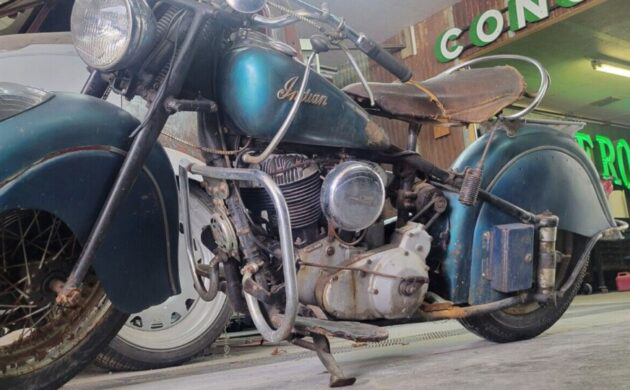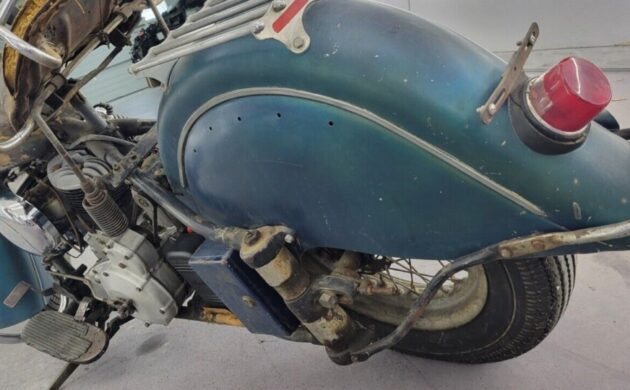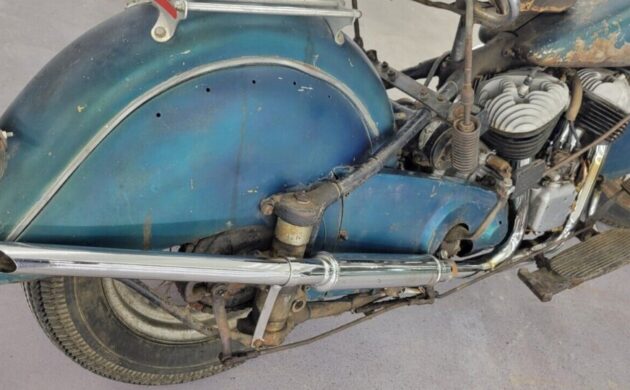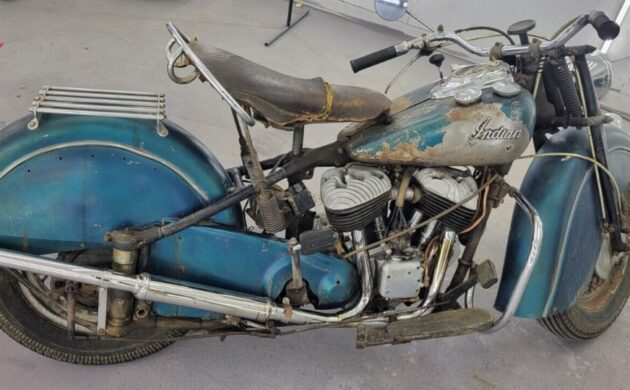The overwhelming urge to restore every old vehicle has waned in the past few decades. In previous years, full restorations were common. It is now socially acceptable to keep an artifact in its original condition as long as it is presentable. Yet, one has to ask where the dividing line is. For example, this 1948 Indian Chief for sale on eBay in Emporia, Kansas could be returned to the road with seemingly little effort. However, would it be better to restore this Seafoam Blue Chief, or get it running and drive it? With just one day to go and bidding at $17,800, someone will have to make that call. What would you do?
There is no denying that a postwar Indian Chief is about as pretty as a motorcycle ever got, or ever will get. The iconic full fenders and sweeping lines just look perfect. That look is what has brought the Indian Motorcycle Company back from the dead numerous times, with the latest incarnation by Polaris Incorporated being the most successful and most likely to stay around. Their offerings pay homage to earlier Indians, but the full-fendered models in their line just don’t exhibit that elegant simplicity in the same manner.
The Indian Chief you see here is a fairly rare representation of the company’s postwar Chief. While the Scout was discontinued after the war because the company thought it was too outdated, the idea was for them to build a new motorcycle along the lines of the British bikes entering the market. The problem was retooling would take time and precious resources the company didn’t have. So, to keep money flowing in, the Chief was kept in production in a largely unchanged state.
While arch-rival Harley-Davidson was developing the Panhead engine and other improvements, the Indian Motorcycle Company was focusing its efforts on a bike that would come too late to save the company. The Chief largely carried the torch for the company with little development, save a few color changes here and there. Your Indian Chief could be had in Deluxe Black, Indian Red, Seafoam Blue, and, occasionally, Prarie Green. Customers could also choose whether to have the throttle on the right or left. This option was mainly for police orders. Cops wanted to keep their right hand free to shoot at suspects while in a high-speed pursuit.
While green is the color listed in the ad, it appears that this Chief was delivered in Seafoam Blue. The majority of Chiefs were delivered in Indian Red, so seeing one in any other color is a novelty at this point. The issue is the condition of that paint. Some areas of the motorcycle are presentable as is, but spilled fuel has made a bit of a mess of the tank. Other areas are pitted, worn, and demonstrate that well-used look. Whether the whole bike is presentable in its present condition is a decision the new owner will have to make.
Overall, the ad and pictures lead us to believe that the motorcycle could be returned to the road with relatively little effort. There are 32,000 miles on the odometer and the top end was rebuilt in 2010. The seller tells us that there are receipts and literature that go with the bike and that the previous owner had it since the 1960s. We are also assured that the engine is not locked up. A competent mechanic well-schooled in the old ways should be able to get the old flathead V-twin purring in no time.
So what would you do with it if you won the auction? A full restoration could run into the tens of thousands quickly. From there you would be left with a beautiful work of art that you would be hesitant to ride. Or, you could get it running and ride it like the thoroughbred that it is. Several folks participate in long-distance tours with vintage motorcycles. Indian Chiefs benefitted from a design that was perfected over many years. Why not spend a few more years driving it?
Would you restore this Indian Chief or return it to the road? Let us know your thoughts in the comments/












I would of course get it running, find and replace any missing trim with used or nos and leave it as is and enjoy it. Reminds me of a 96 Vulcan Classic I had a long time ago. Same fender design- yes the Kawasaki’s were a ripoff of the Indian design ( I got a lot of grief from Harley guys) but just looking at this one brings back memories I haven’t thought of in a long time. Maybe my motorcycle days aren’t completely behind me yet lol
They are beautiful, but… riding any forties Chief takes the concentration of a chess player, the coordination of an acrobat, and the grace of a professional dancer. Lacking these, and you’re going down.
This particular bike has a kick starter, manual choke, left hand ignition advance and front brake, a right hand throttle (not spring loaded), a left foot rocker clutch (not spring loaded), a left hand stick shift, and a right foot rear brake. To ride it safely, you must be wide awake and at the top of your biker game.
Other way around for the throttle and the ignition advance, no? I have encountered a spring-loaded throttle conversion, which was a one-off and almost invisible.
My 1939, 1940 and 1943 Harley’s all had the same configuration as this lovely Indian and I never found it to be a problem.
Bro… too funny.!! And true for some…
I too liked the looks of Kawasaki Drifters, especially when they are done up with the older style seats and leather bags. They are works of rolling art.
This is the real deal, as to weather restore or keep it all original that would be up to the new owner. Either way is good way to invest your money, I don’t know if you would get it all back, but the smiles would be priceless.
Seems like a pretty strong price for a base (Clubman) model Chief that needs mechanical work. It’s a neat piece, though.
They were also offered in yellow (ewwww), and you could have a magneto ignition.
Indian restoration is not very cheap. If you did your own cosmetic work and got lucky on all the mechanical unknowns, you might be able to do it for less than $10,000. Then you’d have about $30,000 and a bunch of time in a $25,000 Clubman. No thanks.
If this was a 47, it would be called a Sportsman. Since it’s a 48 it would just be called a Chief.
The Sportsman had more chrome on it, like this one, than the Clubman.
The Wigwam only produced about 3000 Chiefs in 48. Harley came out with the very popular Panhead in 48 and Indian sales suffered.
I’d let it sit where it is. I’m not opposed to the name Indian Chief, but I just don’t like motorcycles.
I’m sure glad you commented.
Well thanks Joe… I was under the impression that we could express our thoughts here…. As a Native, I’m not as sensitive to “slights” like others, but my dislike of motorcycles comes from personal experiences… n’est-ce pas??
I’d do only the bare bones maintenance to get it running reliably, then drive the hell out of it and enjoy it.
Spark, Fuel, a good right leg to kick ( advance the spark) and hang on…
Older cycles are intended to be used for the Sunday ride when inattentive drivers are less frequent. Yes you can restore it and park it in a museum but why do that when you can ride?
The easier way to start a bike without breaking a leg is to RETARD the spark, and when the engine starts then to advance it. That way there is no backfire to contend with.
I changed to a left-leg toe kick after twisting my ankle doing a right heel kick. This ’48 doesn’t have a rear crash bar to knock the right foot off when heel kicking, though.
The cold start procedure for this ’48 is relatively involved: put trans in neutral, fully engage the clutch, fully open throttle, fully close choke, fully retard ignition, get kick on compression stroke, leave key in OFF position and kick twice to prime, turn throttle back to 1/4 open, open choke to halfway (2 clicks), turn on ignition, kick to start, immediately open choke and fully advance ignition, close throttle to idle, let warm up for 2 minutes before riding.
Like I said, a “thinking man’s” ride. No chicks.
My uncle had a ’48 Chief. Every once and a while he’d ride it to our local cruise in. He’d always get a crowd gathered ’round when he’d kick it over. He was in his 70’s, and I think a lot of the younger guys couldn’t believe he’d get it started.
I like what I see. This could come to my place and I would give it a good home. But, I wouldn’t hesitate to give it a rider-quality restoration. I also wouldn’t hesitate to ride it if it was in showroom condition. They can be ridden and enjoyed just as much and if some cage jockey ruins your day the rat bikes are just as bent and busted as the show bikes. Stripping this down and giving it a good respray would do it a world of good…
The winning bid was $22,750. The seller dinged that one out of the park.
How to start
made from ’28/42 THIS is the Indian model to have.
Not more’n a few mi from where orig manafactured,
right here in Spfld, MA
https://www.youtube.com/watch?v=-13XF-tyldQ
Starting not much different than starting a Model T Ford, with the exception of kick-starting. Used a hand crank.